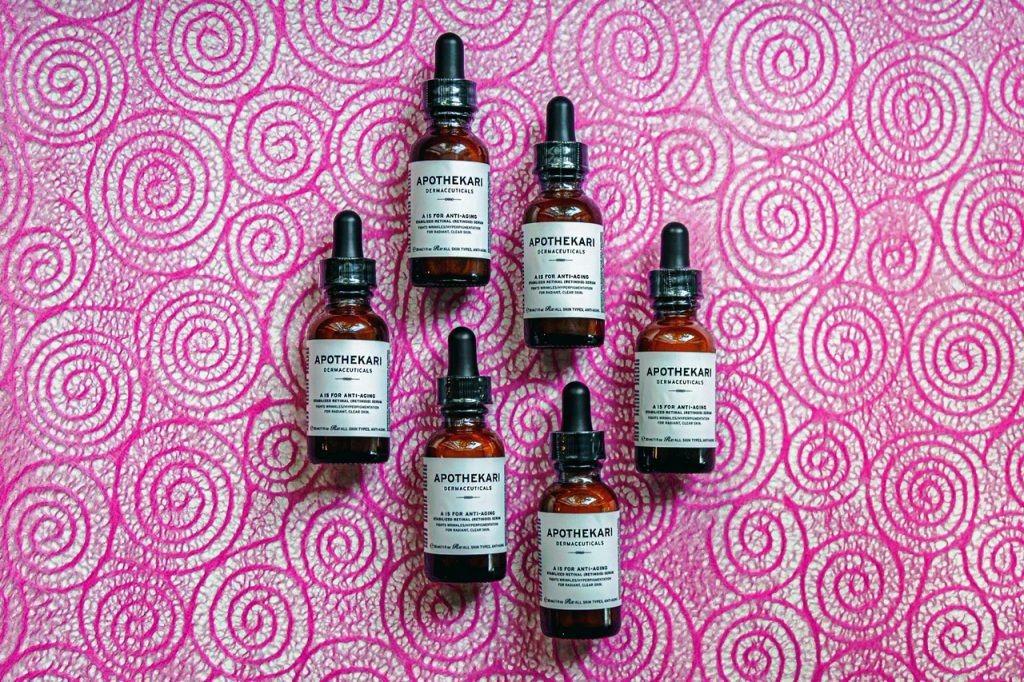If you’re curious about how to reduce wrinkles, this post explains that. Wrinkles are one of the most common symptoms of aging skin, but using the right products – a sunscreen like Shade SPF 30 and a retinoid like A is for Anti-Aging, can help to reduce them.
BUY A IS FOR ANTI-AGINGBuy Apothekari products through our online store – PhaMix.com.
What is a Wrinkle?
Wrinkles are creases, folds, or ridges in the skin, which tend to appear as we get older. They are most frequently found on parts of the body that are exposed to sunlight, including the face, the neck and chest, the back of the hands and the arms. Sun damage, smoking, some medications and dehydration along with environmental and genetic factors can influence their development. Facial expressions, such as repeatedly smiling, frowning, or squinting may also lead to fine lines and wrinkles. And, the thinner, drier and less elastic skin that accompanies aging, impact their formation as well.
Younger skin has more elasticity, allowing it to spring back. The aging process makes springing back harder and less frequent, resulting in permanent lines aka, wrinkles.
Wrinkles – Lifestyle and Environmental Factors
Unprotected exposure to UV light is thought to be one of the biggest contributors to wrinkle development. UV rays break down collagen and elastin fibers, which form part of the skin’s supporting network. This damage results in skin that is weaker and less flexible, causing it to droop and wrinkles to develop. This why sun protection is one of the best things you can do to reduce wrinkles.
- Wear a broad spectrum, UVA/UVB blocking sunscreen with a minimum SPF of 30 every day, year round. Shade SPF 30 is a naturally safe, mineral-based (zinc oxide) and non-whitening formulation to consider
- Cover up with clothing, seek shade, wear hats and sunglasses to protect skin against sun damage
Smoking speeds up the aging process by reducing blood supply to the skin. Excess consumption of alcohol can result in dehydration, which causes skin to become dry and appear more wrinkled. And finally, sleeping on your side or face contributes to face lines while repetitive facial expressions (like squinting) overworks facial muscles and can result in grooves beneath the skin’s surface, which eventually leads to wrinkles.
Treatments That Reduce Wrinkles

When it comes to topical ingredients, there are a few that can help, but retinoids, which are derived from vitamin A, are supported by the most amount of research to support their efficacy in the reduction of fine wrinkles. They have also been shown to reduce pigmentation and decrease skin roughness.
Retinoids include ingredients such as retinoic acid, retinaldehyde, retinol and retinyl palmitate. They work by increasing the production of collagen and by stimulating the production of new blood vessels in the skin, which improves skin color. It takes about three to six months of regular use before improvements in wrinkles are apparent and the best results take six to 12 months.
The one downside of retinoids is that they can cause skin dryness and irritation so it may be useful to gradually work up to nightly applications, especially if you have sensitive skin. Retinaldehyde, which is found in A is for Anti-Aging is effective and one of the gentlest forms of retinoid available, making it suitable for most skin types. Retinaldehyde has the added benefit of being antibacterial, which delivers benefit to acne sufferers as well. A is for Anti-Aging also contains niacinamide, which can stimulate collagen production. The combination helps to minimize fine lines and wrinkles. Keep in mind that retinoids are broken down in sunlight so apply this serum at night in order to maximize benefits.
A two-pronged approach will serve you best when it comes to wrinkle reduction: sunscreen every day in the morning and a retinoid each night.




